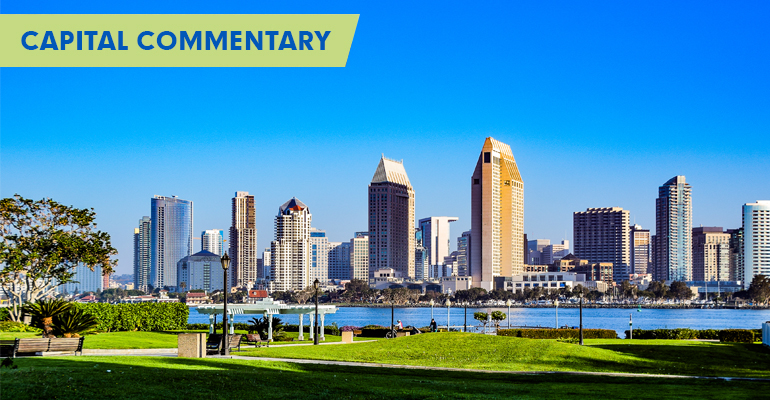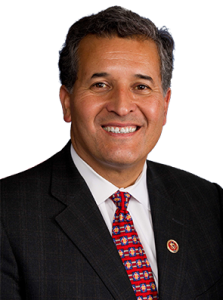
1,478 words. Five-minute read. See item #5 for Capital Commentary Contest.
Rocked by bribery scandals and the embarrassment of losing the 1972 Republican National Convention to another city, San Diego, California, was desperate for a civic boost to assuage sore egos. Along came then-Mayor Pete Wilson, later a U.S. senator and governor, proclaiming his town “America’s Finest City.”
Hyperbolic? Sure. Exaggerated? Maybe. But the nickname stuck, and it remains in use today (for instance, this past August marked the 44th America’s Finest City Half Marathon). And despite a recent survey showing it is the eighth most-disliked city nickname, many of us who once called San Diego home (or still do) take a certain pride in the slogan.
Currently, it may be living up to “America’s Finest City” when it comes to housing innovations, showing the rest of the country how best to address a shortage of homes while also seeing steady population growth. This issue of Capital Commentary leads off with reviewing San Diego’s approach, adds a new newsletter feature (Tweet to Repeat) and concludes with a twist on our contest: a political typology quiz courtesy of the Pew Research Center.
1. Build Up, Not Out
Many of San Diego’s housing challenges can be summed up in one word: space. Or, more specifically, a lack thereof.

U.S. Rep. Juan Vargas, D-Calif.
As State Rep. Juan Vargas (D-Calif.) explained to reception attendees at the recent Mortgage Bankers Association convention in his hometown, “To the south, there’s Mexico. To the west, the Pacific Ocean. To the east, there is desert and mountains, difficult places to build homes. And to the north is Camp Pendleton. And the last time we asked about expanding our residential areas there, the commanding officer reminded us that the U.S. Marines are in the business of taking land, not giving it up.”
The need for additional housing is great.
The San Diego Association of Governments (SANDAG) forecasts a 13% increase in population by 2050, requiring an additional 330,000 housing units.
Faced with rising demand amid severe land limitations, San Diegans are stepping into a brave new world of building multifamily housing in historically single-family neighborhoods.
The story is best told by Conor Dougherty (my guest for Episode 12 of the Arch MI PolicyCast video podcast) in his recent New York Times article, “Where the Suburbs End.”
Dougherty’s article centers on Clairemont, a 1950s creation of developers offering the suburban lifestyle to a postwar America. As San Diego has grown, Clairemont now finds itself in the center of the city rather than on its outskirts.
Like in so many other cities across the land, the centerpiece of that suburban lifestyle was single-family homes.
They were crafted, says Dougherty, in a “political bargain that says sprawl can sprawl and downtowns can rise, but single-family neighborhoods are sealed off from growth. … The deal is almost never stated so plainly, but it is the foundation of local politics in virtually every U.S. city and cuts to the core of the country’s deepest class and racial conflicts.”
Those days are gone in San Diego. Today, converted garages and backyard sheds — Accessory Dwelling Units (ADUs) in the terminology of urban planners — are transforming Clairemont, spurred by state legislation designed to make them easier to build. More recently, two bills signed by California Gov. Gavin Newsom will allow homeowners to add up to three more units on each lot currently designed for single-family homes.
It is a return to yesteryear, writes Dougherty:
“There was an earlier version of California living, one where urban neighborhoods had apartments next to houses and suburbs had boarding units and small-scale farms that families used for food and extra income, making their property work for them. The state’s housing future is starting to look like that homestead past.”
Says SANDAG, the regional planning agency: “At the turn of the century, about 90% of vacant residential land in the cities was planned for single-family use. SANDAG’s latest forecast shows 84% of housing growth by 2050 being multifamily.”
2. A Trolley Runs Through It
The housing crisis in San Diego can’t be addressed solely by ADUs, of course. So, the region spent $2.2 billion to expand the San Diego Trolley line to increase ridership and spur multifamily housing construction along its corridors.

The new line, which opened just before Thanksgiving, connects Old Town San Diego to La Jolla, the University of California San Diego, Mission Bay, Pacific Beach and Clairemont.
It is the region’s first trolley line to run through affluent neighborhoods, and officials hope to attract so-called “choice riders” who can drive or ride the train.
S. Rep. Scott Peters of San Diego told the Los Angeles Times that the new line could be a “game-changer because of the unprecedented opportunity to connect jobs and housing.”
“The new trolley line comes at an ideal time for two crucial city initiatives: a plan to solve a housing-affordability crisis with high-rise buildings near transit and a plan to cut greenhouse-gas emissions by reducing commuting by vehicle,” wrote the Times.
Trolley expansion is kickstarting multifamily construction.
- In October, the San Diego Metropolitan Transit System’s board approved an agreement to build 390 housing units for low- and moderate-income families at the Palm Avenue Trolley Station, three stops from the border city of San Ysidro.
- Earlier this year, the ground was broken on a 250-unit housing project near a station northeast of downtown.
The new trolley line will cut 90 minutes off the daily commute of one prospective rider from San Diego’s South Bay to University City, at the northern edge of San Diego — and, at $2.50 for a one-way ticket, it is less than a cup of coffee at Starbucks.
3. First-Hand Education in Housing
California college students are learning about the challenges of affordable housing in an up-close and personal way.
University of California Santa Barbara senior Kris Hotchkiss returned to school only to learn the campus and surrounding community are facing a severe shortage of student housing.
“Hotchkiss had to endure a leaking roof, soggy bedding and power failure that shut down the ceiling fan, refrigerator and lights for six weeks. He has no shower or toilet. That’s because he lives in a van — the only affordable shelter he could find,” reported the LA Times.
Hotchkiss isn’t alone.
Nazwari Allen searched fruitlessly for an off-campus apartment in nearby Isla Vista, California, but found “that option is pretty much out the window” in his price range. He, too, may be forced to live in his car.
Meanwhile, Zach McGlynn and Luke Hamilton are staying in relative luxury at the Best Western South Coast Inn. The room has two beds but no cooking facilities, so the pair live on protein bars and fast food.
Long Beach City College is trying to help by setting aside spots to allow 15 students living in cars to park overnight in a campus parking structure. So far, two students are sleeping in their cars on campus, and nine more have applied.
The cause of the student housing shortage mirrors housing problems throughout the state: too many people and regulatory hoops that have delayed the construction of more dormitories.
Since 2015, the nine-campus University of California has added nearly 30,000 students but only 23,000 beds.
4. Tweet to Repeat: Homeownership Matters

In the first sentence, Loftin means that the average black homeowner pays less per month on a mortgage than what the average renter pays per month, regardless of the renter’s race.
Loftin is a visiting fellow at the Urban Institute and CEO of Homewise, Inc., a nonprofit promoting sustainable homeownership.
5. Contest #12: What’s Your Type?
I’m always intrigued to know more about the readers of Capital Commentary and appreciate the many calls and emails I’ve received over the months of publishing this newsletter from people sharing their thoughts and concerns. I find myself fascinated to know where readers align on the political spectrum.
Thanks to the non-partisan Pew Research Center, readers can uncover which of nine different political typecasts best matches their views.
The Political Typology Quiz takes only about two minutes to complete. For Contest #12, I ask you to take the quiz and send an email to [email protected] by midnight on Dec. 9 with your typology in the Subject line.
We’ll award an Arch MI Capital Commentary mug and saucer to a reader in each of the selected categories (and your typology won’t be shared with anyone). Click to begin the quiz.

Do you think Capital Commentary offers valuable information on housing policy and its potential impacts? If you do, share your comments with us. Your feedback will help ensure Capital Commentary covers the stories that have the most impact on your business.

About Arch MI’s Capital Commentary
Capital Commentary newsletter reports on the public policy issues shaping the housing industry’s future. Each issue presents insights from a team led by Kirk Willison.
About Arch MI’s PolicyCast
PolicyCast — a video podcast series hosted by Kirk Willison — enables mortgage professionals to keep on top of the issues shaping the future of housing and the new policy initiatives under consideration in Washington, D.C., the state capitals and the financial markets.
Stay Updated
Sign up to receive notifications of new Arch MI PolicyCast videos and Capital Commentary newsletters.